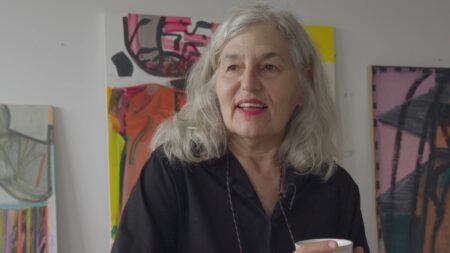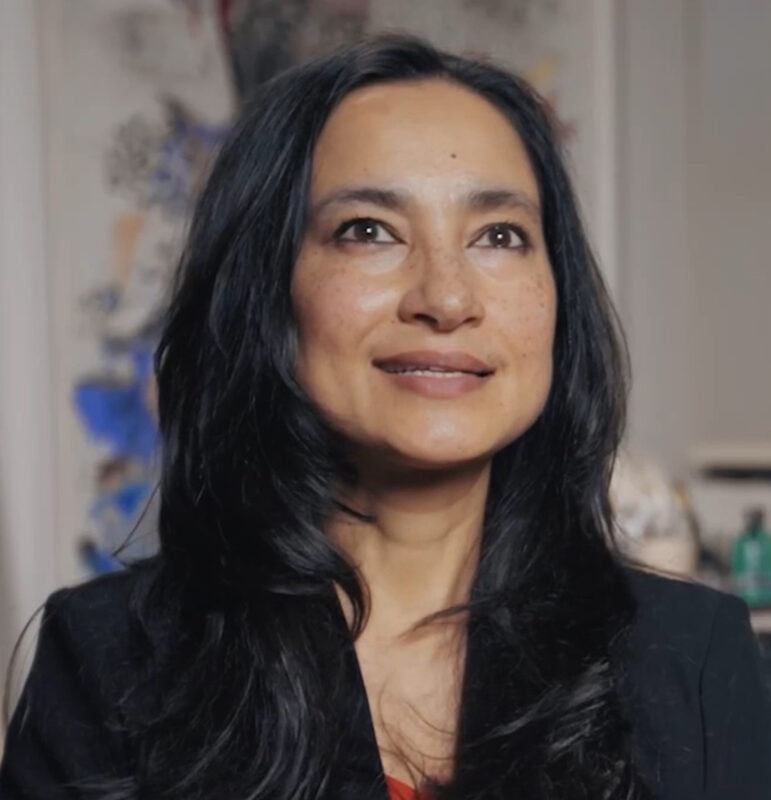Continue playing
(Time remaining: )
Play from beginning
Continue playing "{{ controller.videos[controller.getVideo(controller.currentVideo)].segmentParentTitle}}"
{{controller.videos[controller.getVideo(controller.currentVideo)].title}} has ended.
Melting BoundariesShahzia Sikander
Visit our Awards page for this film’s honors and recognition.
In Madison Square Park, Shahzia Sikander watches as her bronze sculpture Witness (2023) is installed a short distance from its counterpart, Now (2023), Sikander’s sculpture that sits atop the Appellate Division, First Department, Supreme Court of the State of New York alongside statues of famous lawmakers like King Louis IV and Moses. The two figures are components of a public exhibition co-commissioned by the Madison Square Park Conservancy and Public Art of the University of Houston System, titled Havah…to breathe, air, life (2023), through which Sikander aims to reimagine the monument as a marker of boundary-breaking, feminine spirit, and collective visibility. Prior to this most recent project, the artist has spent nearly three decades developing traditional Indian and Persian art techniques into a visual language that addresses colonial histories and erasures. “I like to think of my practice as an anti-monument,” says Sikander, “because it engages the past without glorifying it.”
To create her monumental sculptures, the artist began thinking of the fluid and fantastical feminine forms that appear in her paintings, such as Pleasure Pillars (2001) and A Slight and Pleasing Dislocation (2001). Sikander’s new sculptures build on the powerful depictions of the feminine in her previous work while incorporating new elements specific to the particular site and context of the public works. Witness symbolically bursts through the stained glass ceiling of the courthouse, the glass mosaic detailing of her hoop skirt depicting the shattered glass, while the jabot worn prominently by both figures calls to Ruth Bader Ginsberg’s feminization of the traditional black robes worn by justices of the United States Supreme Court. Joining park visitors to view the statues as they lower into place, Sikander contemplates the works’ timely nature in light of recent legislative battles surrounding women’s reproductive rights in the United States, as well as the ongoing fight for equitable representation in society at large. “Whenever we create art and put something in the world, it pushes the envelope of who gets to be represented even further,” says Sikander. “These things are integral to how art can then negotiate a space for a future generation.”
More information and creditsCredits
CREDITS | Extended Play Series Producer: Ian Forster. Director & Producer: Andrea Yu-Chieh Chung. Editor: Jiale Hu. Camera: Sean Hanley, Jane Macedo Yang, Doug Potts. Additional Camera: Legash Covenas (UAP), Chris Roque (UAP). Sound: Jan Midelfort, Fivel Rothberg. Production Assistant: Stephanie Cen. Colorist: Cédric von Niederhäusern. Sound Mix: Collin Blendell. Assistant Editor: Michelle Hanks. Music: Artlist. Archival Material: The Metropolitan Museum of Art. Artwork Courtesy: Shahzia Sikander, Sean Kelly Gallery. Special Thanks: Madison Square Park Conservancy; Appellate Department, First Division, Of the State of New York; KC Fabrications; Miotto Mosiac Art Studios; UAP.
Extended Play is presented by the Marina Kellen French Foundation, with support from The Andy Warhol Foundation for the Visual Arts, public funds from the New York City Department of Cultural Affairs in partnership with the City Council, the New York State Council on the Arts with the support of the Office of the Governor and the New York State Legislature, the Art21 Contemporary Council, and individual contributors. Producers: Barbara & Andrew Gundlach.
Closed captionsAvailable in English, German, Romanian, Italian, Japanese, Korean, Chinese, Italian
Through the Art21 Translation Project, multilingual audiences from around the globe can contribute translations, making Art21 films more accessible worldwide. Translate this video now.
Interested in showing this film in an exhibition or public screening? To license this video please visit Licensing & Reproduction.
Shahzia Sikander specializes in Indian and Persian manuscript painting, a traditional, technique-driven style that Sikander imbued with a personal context and history, blending the Eastern focus on precision and methodology with a Western emphasis on creative, subjective expression. In doing so, Sikander transported manuscript painting into the realm of contemporary art. Expanding the manuscript painting to the wall, Sikander also creates murals and installations, using tissue-paper-like materials that allow for a more free-flowing style. Utilizing performance and various media and formats to investigate issues of border crossing, she seeks to subvert stereotypes of the East and, in particular, the Eastern Pakistani woman.
“I often think of my practice as an anti-monument, because it engages the past, but it doesn’t glorify the past.”
Shahzia Sikander

